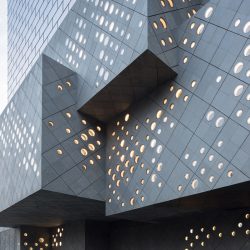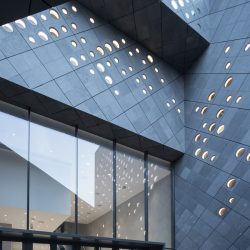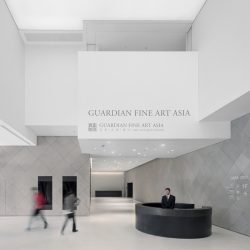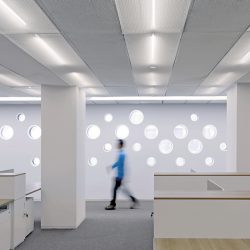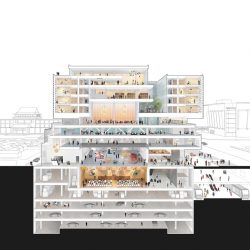6 YEARS AFTER THE COMPLETION OF CCTV, OLE SCHEEREN IS BACK TO MAINLAND CHINA ONCE AGAIN
In 2010, Ole Scheeren, an important partner of OMA, the office behind China’s epic CCTV Headquarters (2012), left the firm to open his own office, Büro Ole Scheeren. His office has worked on several projects in the Southeast Asian region and taken part in big design competitions worldwide. The Guardian Art Center in Beijing that officially opened in early 2018 marks Ole Scheeren’s return to China.
- THE GRANDIOSE SCALE OF THE NORTH ENTRANCE
Guardian Art Center is an art auction center that incorporates the functional spaces of a hotel, restaurant and a multifunctional area into one project. The Guardian Art Center’s building is located to the northeast of the Forbidden City on the corners of Wusi and Wangfujing streets. The area is one of Beijing’s most important commercial districts and is surrounded by an impressive number of works of ancient architecture. Having to place a 55,988-square-meter structure into an area with a height restriction law and ancient courtyard houses as its neighbors required that almost half of the building be planted in the ground in order to minimize the presence of the immense size of the architecture. The edifice was therefore divided into a series of superimposed cubical masses. The separation of the architectural mass to facilitate a connection between the interior and exterior spaces has been Scheeren’s approach toward many of the projects he has designed. One example of such is Collaborative Cloud, a design proposed for the pitching competition of Axel Springer media headquarters in Berlin where the architect created a pixelated void carved into the center of the building in order to create different levels of spatial flexibility and connectivity. With Guardian Art Center, he formed a series of varying architectural masses allowing for the building to be physically connected to the surrounding urban fabric. By digesting the building into separated yet interconnected parts, the design attempts to maintain its connection with the neighboring small structures such as ancient houses and Hutong. In the meantime, the presence of a court at the center of the top part of the program resembles the enclosed courts of ancient Chinese houses.
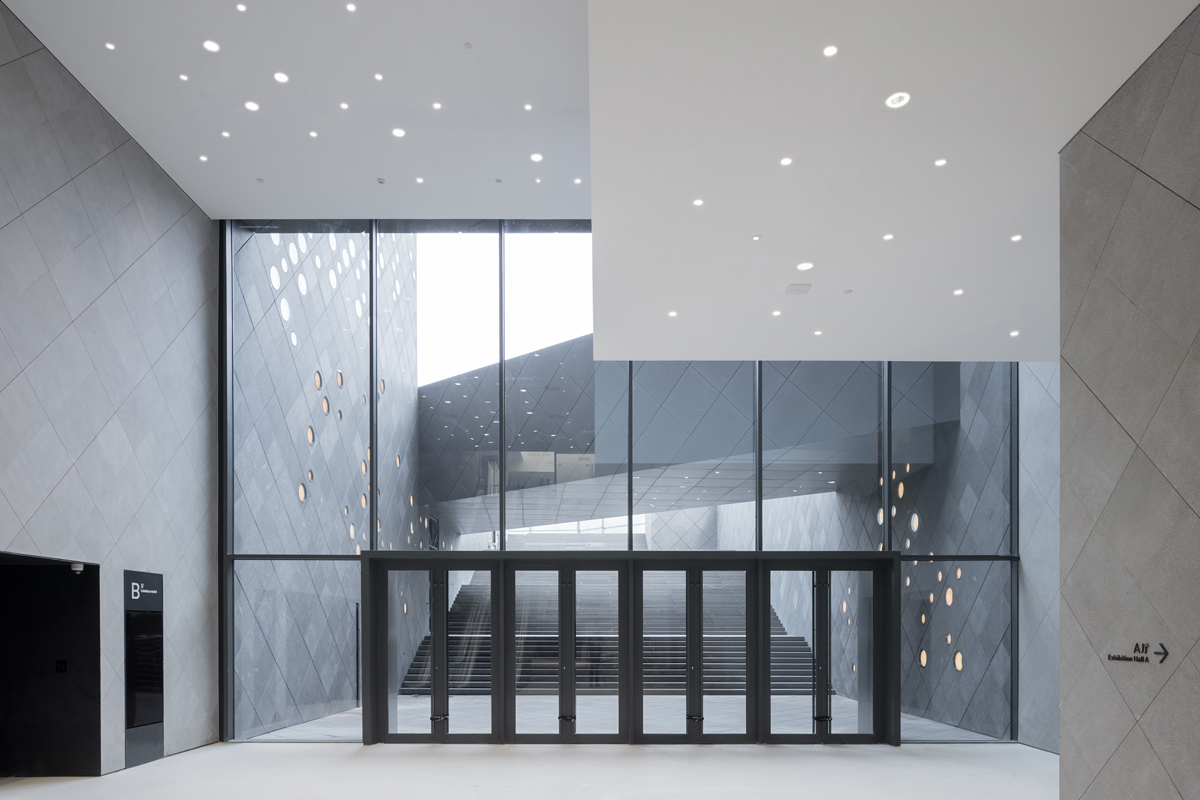
The top cubical mass contains the space of the hotel and is beautifully cladded with glass blocks of a customized size. The blocks are arranged to be of a similar pattern to the brick walls of ancient Chinese homes. The details of the perforations of the bottom mass were inspired by Huang Gongwang’s 12th Century landscape painting, “Dwelling in the Fuchun Mountains” (富春山居圖).
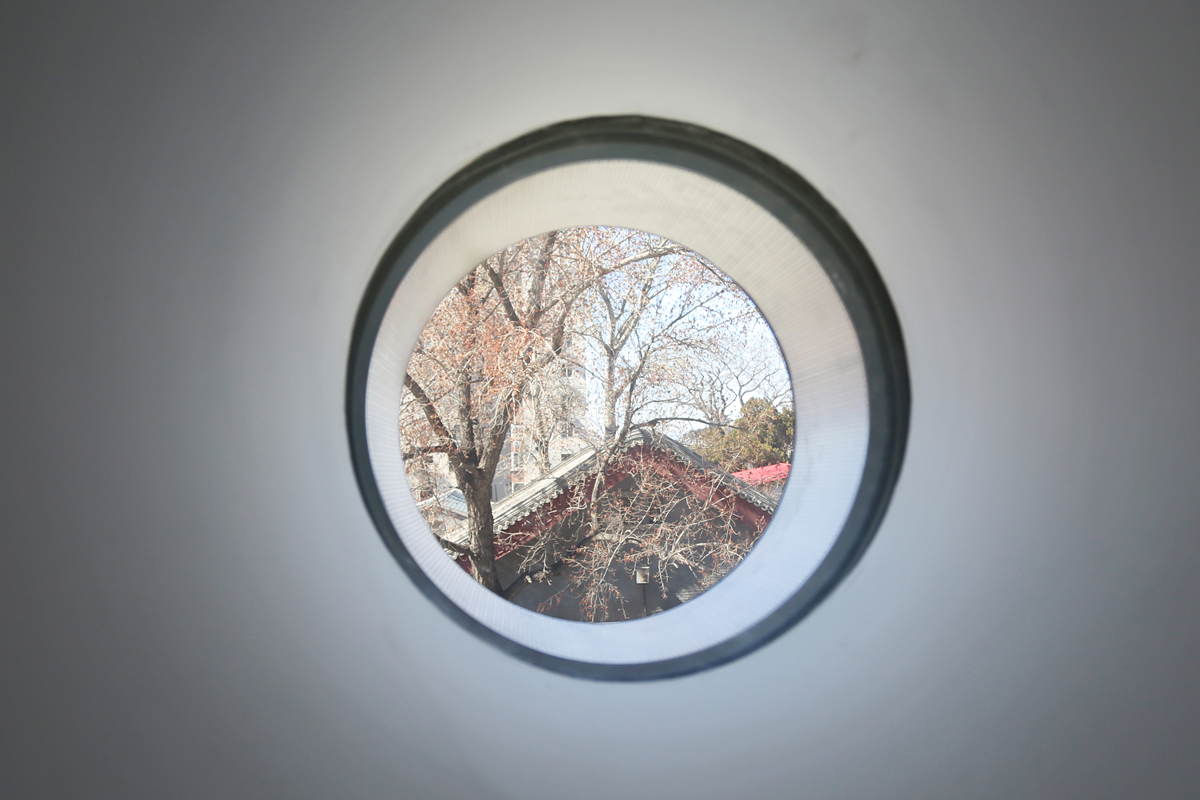
The course of only two decades since China opened the country and adjusted itself to a capitalist economy has brought about tremendous changes. One of the most tangible sources of evidence of this period of great transformation is the urban growth that has been followed by the blossoming of unusual-looking architecture. Gentrification has become inevitable as neighborhoods that are homes to ancient architecture are being invaded and destroyed for fiercely competing real-estate development projects, especially prior to the opening of the Beijing Olympics in 2008 as China strived to show the world its modernized self. As the economic growth begins to slow down, environmental crises have emerged in the form of air pollution, troubling Beijing and other big cities while people grow to become more conscious of the environment and desire a better quality of life. Over the past 5-6 years, we have witnessed a growing interest in these issues, especially the preservation approach being taken toward historic architecture that aims for renovation rather than demolition of ancient structures. Buildings are designed with greater environmental consciousness and are made to consume less energy. China’s architectural tendencies will no longer be about just the creation of iconic edifices by starchitects and Guardian Art Center is another example that reflects such promising change.
- AN AUCTION PRE-FUNCTION HALL AT THE NORTH ENTRANCE
- THE INTERIOR VIEW OF THE GUARDIAN ART CENTER’S OFFICE
- THE INTERIOR VIEW OF THE EXHIBITION SPACE
- THE INTERIOR VIEW OF THE MAIN AUCTION HALL
ในปี 2010 Ole Scheeren หนึ่งใน partner คนสำคัญของ OMA เจ้าของโครงการมหากาพย์อย่างตึก CCTV (2012) ได้แยกตัวออกมาก่อตั้งสำนักงาน Büro Ole Scheeren เป็นของตัวเอง จากนั้นเขาก็ออกตระเวนทำงานอยู่ในแถบเอเชียตะวันออกเฉียงใต้ รวมทั้งเข้าร่วมงานประกวดแบบสำคัญๆ อีกหลายแห่งทั่วโลก ดังนั้นโครงการ Guardian Art Center ในปักกิ่ง ที่เพิ่งเปิดตัวอย่างเป็นทางการเมื่อต้นปีที่ผ่านมา จึงอาจเรียกได้ว่าเป็นการกลับมาสร้างงานในจีนอีกครั้งสำหรับ Ole Scheeren
Guardian Art Center เป็นศูนย์ประมูลศิลปะที่นำเอาพื้นที่ใช้สอยอย่าง โรงแรม ภัตตาคารพื้นที่จัดงานอเนกประสงค์ เข้ามารวมกันไว้ในโครงการเดียว ตัวอาคาร Guardian Art Center ตั้งอยู่ทางด้านทิศตะวันออกเฉียงเหนือของพระราชวังต้องห้าม บนหัวมุมถนน Wusi ตัดกับถนน Wangfujing ซึ่งเป็นย่านการค้าสำคัญของกรุงปักกิ่ง และแวดล้อมไปด้วยสถาปัตยกรรมโบราณจำนวนมาก การที่ต้องจัดวางอาคารขนาด 55,988 ตารางเมตรลงไปในย่านที่มีข้อจำกัดเรื่องความสูงและตั้งอยู่ใกล้กับย่านที่เป็นบ้านคอร์ตยาร์ดจีนโบราณ ทำให้ต้องใช้วิธีฝังพื้นที่อาคารเกือบครึ่งลงไปใต้ดิน เพื่อที่จะทำให้ตัวอาคารไม่ได้ดูใหญ่เทอะทะจนเกินไป และยังมีการแบ่งแยกมวลอาคารออกเป็นรูปทรงลูกบาศก์หลายขนาดซ้อนๆ กันอยู่ ซึ่งวิธีการแตกมวลอาคารเพื่อให้เกิดการเชื่อมต่อในระดับทั้งพื้นที่ภายในและภายนอกนั้นถูกนำมาใช้ในหลายโครงการที่ออกแบบโดย Scheeren ไม่ว่าจะเป็นโครงการ Collaborative Cloud ที่เป็นการประกวดแบบอาคารสำนักงานใหญ่ทางด้านสื่อในกรุงเบอร์ลิน โดย Scheeren ใช้วิธีการสร้างโถงกลางขึ้นมา แล้วสร้างมวลอาคารที่มีลักษณะยืดหดในหลายระดับเพื่อสร้างความเชื่อมต่อระหว่างพื้นที่ส่วนต่างๆ บริเวณใจกลางอาคาร ขณะที่โครงการ Guardian Art Center นั้น เขาใช้วิธีสร้างมวลอาคารที่ยืดหดต่างกันเพื่อเชื่อมต่อกับพื้นที่เมืองโดยตรง รวมไปถึงการทอนมวลอาคารออกเป็นหลายๆ ส่วนเพื่อให้เกิดความเชื่อมโยงกับกลุ่มอาคารขนาดเล็กอย่างบ้านโบราณและหูต่ง (Hutong) และขณะเดียวกันก็สร้างพื้นที่คอร์ตภายในตรงใจกลางอาคารส่วนด้านบนสุดแบบเดียวกับการปิดล้อมพื้นที่ตรงกลางของบ้านจีนโบราณ
ในส่วนวัสดุหุ้มพื้นผิวอาคาร มวลอาคารลูกบาศก์ด้านบนสุดที่เป็นส่วนของโรงแรมถูกหุ้มด้วยอิฐแก้วขนาดพิเศษที่มีการจัดเรียงให้คล้ายคลึงกับการเรียงกำแพงอิฐของบ้านโบราณ ส่วนอาคารด้านล่างก็สร้างช่องเปิดวงกลม โดยได้แรงบันดาลใจมาจากภาพทิวทัศน์ Dwelling in the Fuchun Mountains (富春山居圖) ในศตวรรษที่ 12 ของจิตรกรโบราณอย่าง Huang Gongwang
ระยะเวลาเพียงสองทศวรรษที่จีนเปิดประเทศและปรับระบบเศรษฐกิจเป็นแบบทุนนิยม ได้นำความเปลี่ยนแปลงมหาศาลมาสู่จีน โดยเฉพาะอย่างยิ่งสิ่งที่เห็นเป็นรูปธรรมอย่างชัดเจน นั่นคือ การขยายตัวของเมือง และสถาปัตยกรรมรูปทรงแปลกตาที่ผุดขึ้นมาราวกับดอกเห็ด ขณะเดียวกันการทำลายพื้นที่ย่านพักอาศัยเก่าแก่ดั้งเดิมที่เต็มไปด้วยสถาปัตยกรรมโบราณ เพื่อนำมาก่อสร้างโครงการอสังหาริมทรัพย์ก็เป็นไปอย่างดุเดือด โดยเฉพาะอย่างยิ่งในช่วงก่อนการเปิดกีฬาโอลิมปิกที่กรุงปักกิ่งในปี 2008 ด้วยต้องการแสดงให้โลกเห็นว่าจีนกำลังก้าวเข้าสู่ยุคใหม่ และเมื่อเศรษฐกิจเริ่มชะลอความร้อนแรงลง ในขณะที่หายนะทางสิ่งแวดล้อมเริ่มส่งสัญญาณให้เห็นผ่านหมอกควันพิษเหนือกรุงปักกิ่งและในหลายเมืองใหญ่ ประชาชนเริ่มเห็นความสำคัญของเรื่องสิ่งแวดล้อมและมีความต้องการในเรื่องสุนทรียภาพในการใช้ชีวิตมากขึ้น ตลอดระยะเวลา 5-6 ปีที่ผ่านมา เราจึงได้เห็นว่ากระแสความสนใจต่อประเด็นเหล่านี้มีความชัดเจนมากยิ่งขึ้น โดยเฉพาะอย่างยิ่งในงานสถาปัตยกรรมที่เริ่มมีโครงการปรับปรุงอาคารเก่าที่มีความสำคัญทางประวัติศาสตร์เพื่อนำกลับมาใช้ใหม่แทนการรื้อทิ้งแล้วสร้างใหม่เหมือนเช่นในอดีต มีการออกแบบอาคารที่ให้ความใส่ใจต่อเรื่องสิ่งแวดล้อมและการประหยัดพลังงานมากขึ้น ดังนั้นรูปแบบทางสถาปัตยกรรมของจีน นับแต่นี้ไปคงจะไม่ใช่การสร้างสถาปัตยกรรมแบบ iconic โดยสถาปนิกซุปเปอร์สตาร์ แบบที่แล้วๆ มาอีกต่อไป โครงการ Guardian Art Center ก็จัดเป็นอีกหนึ่งตัวอย่างที่สะท้อนให้เห็นถึงกระแสความเปลี่ยนแปลงนี้ได้ดี
TEXT: AROON PURITAT
PHOTO : IWAN BAAN (EXCEPT AS NOTED)
buro-os.com



